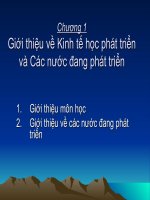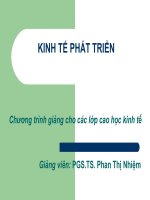Bài giảng Kinh tế phát triển: Quản lý nguồn lực ở Việt Nam (Slide thầy NH Bảo UEH)
Bạn đang xem bản rút gọn của tài liệu. Xem và tải ngay bản đầy đủ của tài liệu tại đây (739.11 KB, 43 trang )
Nguyen Hoang Bao
University of Economics
Ho Chi Minh City, Vietnam
• There are 4 gaps in Vietnam: S
• Human resource, financial resource, physical resource, natural
resources, social resource, and cultural resource are not only
shortage, but also being underutilized.
• Utilization of all resources is based on many groups of factors,
such as institution, education, and reform initiatives.
1
2
3
4
Concepts
Theoretical framework
Empirical studies of Asian Countries
Policy implications for Vietnam
•
•
•
•
•
•
Human resource
Financial resource
Physical resource
Natural resource and environment
Social capital/resource
Cultural capital/resource
Human resource
• Human resource is one of four factors of production
(land, capital goods, human capital, and technology)
Physical capital
• Physical capital refers to any non–human asset made
by humans and then used in production
Natural resource management
and environment
• Exists relatively undisturbed by mankind, in a natural
form and is characterized by the amount of
biodiversity existent in various ecosystems.
• How to manage land, water, soil, plants, and animals
in order to improve quality of life for both present
and future generations.
Social capital
• Facilitate co–operation and mutually supportive
relations in communities and nations (Putnam, 1993).
• Access to information and skill sets and enhanced
power (Uzzi & Dunlap, 2005).
• Facilitate individual or collective action, generated by
networks of relationships, reciprocity, trust, and social
norms (James Coleman, 1988).
Cultural capital
• Knowledge (worldview, technology, social structure)
• Values (Truth of Asia, truth of Vietnam)
• Norms
Agenda
1
2
3
4
Concepts
Theoretical framework
Empirical studies Asian Countries
Policy implications for Vietnam
Comparative analysis of natural resources
and other resources for development
a)
b)
c)
d)
e)
f)
g)
Accumulation
Tangible and intangible assets
Worn–out and value–added
Multi–purposes
Calculate discount rate
Transformation
Maintain
Comparative analysis of natural resources
and other resources for development
Human Financial Physical Natural Social
Cultural
resource resource resource resource resource resource
Accumulation
✔
Tangible assets
✔
✔
✔
✔
✔
✔
✔
✔
Worn–out
✔
Multiplicity of uses
✔
✔
Discount rates
✔
✔
Transformation
✔
✔
Maintainability
✔
✔
✔
✔
✔
✔
✔
✔
✔
✔
✔
✔
✔
Agenda
1
2
3
4
Concepts
Theoretical framework
Empirical studies Asian Countries
Policy implications for Vietnam
Growth rate of GDP per capita of some countries
(fixed price of year 2000)
1960 – 1984
1984 - 1997
1997 – 2006
1960 – 2006
Philippines
1.7
1.3
2.2
1.4
Pakistan
3.0
2.0
2.2
2.7
India
1.5
3.3
4.7
2.8
Indonesia
3.7
5.1
2.7
3.6
Vietnam
na
4.3
5.2
na
Malaysia
4.3
4.9
2.9
3.9
Thailand
4.6
6.4
3.6
4.7
China
3.8
7.9
7.6
6.1
South Korea
5.6
6.6
4.5
5.6
Japan
5.5
2.4
1.1
3.8
United States
2.3
1.8
1.6
2.2
Source: World Development Indicators 2008
Comparative labor force utilization
Source: Economic Intelligence Unit (2008)
Comparative labor productivity
Source: Asia Community Research Center (2008)
Comparative prosperity performance
Source: Economic Intelligence Unit (2008)
Stage of development
GDP per capita
Sustainable development
(Korea, Singapore)
Primary market economy
Unsustainable development
(Philippines, Indonesia)
Traditional society
time
Philippines
• Gave no incentive to absorb modern technology and
improving productivity.
• Constrained business environment and international
competitiveness (Aldaba, 2002).
• High costs of business/Corruption/Political patronage
• After Marco regime, country is more democratic,
opportunity equality, but instability institution (As a
result, country did not receive Japanese investment
(lack of international resource) (Pritchett, 2003).
Indonesia
• Indonesia belongs to East–Asia Miracle (WB, 1993). Country
was severe impacts of financial crisis 1997. Required 8 years
to recovery to the year 1997! And then slow economic growth.
• Before 1980: do not intervene market/create market–
friendly/protect infant industry to exports.
• Crony capitalism (Suharto regime)
• Corruption (Hall, 2000)
• Unchecked authority
China
• Town–Village Enterprises (TVEs) (1985–2004)
• Foreign direct investment: $0 (1978), $1.66 bil
(1985), $3.49 bil (1990), $37.5 bil (1995), $40.72 bil
(2000), $60.33 bil (2005), $ 69.47 bil (2006)
• Chinese overseas
Chinese industrial output categorized by
ownership (1970– 1999) (%)
Year
State–owned
Cooperative
Private
Others
1970
87.61
12.39
0
0
1978
77.63
22.37
0
0
1984
69.09
29.71
0.19
1.01
1996
36.32
39.39
15.48
16.65
1999
28.21
35.37
18.18
26.14
Source: Fulbright Economics Teaching program (2008)
Chinese industrial output categorized by
ownership 2005
Number of
enterprise
Gross output
Proportion (%)
(billion Chinese
Yuan)
State – owned
25339
2351.9
10.6
Joint – stocked
17427
2312.1
10.4
Cooperative
191869
1321.6
5.9
Private
902647
4970.5
22.4
Hong Kong
54910
2438.6
11.0
Foreign – owned
51255
4275.1
19.2
131816
4561.8
20.5
Others
Source: Fulbright Economics Teaching program (2008)
Chinese energy, raw material, and water
for one unit of GDP
Energy (higher than Germany 4.9 times, Japan 4.3
times, and US 2.1 times)
Raw materials (higher than US 10 times, Japan 20
times, Germany 6 times, and India 1.65 times)
Water (higher than DCs 10 times)
Pollution









